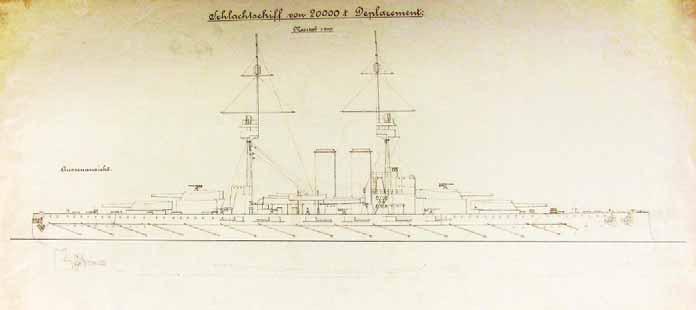MTK design. In her proportions she resembled contemporary German battleships. Her torpedo protection system was very interesting: instead of a single torpedo bulkhead it was consisted of a second, internal, vertical double-bottom, with 45 mm (22.5+22.5) and 15 mm plating. The distance between the two plating was 700 mm.358 Distance between the ship’s side shell plating and the 45 mm plating is unknown. The torpedo protection system of the MTK 24,500 ton design was similar to the former 25,200 ton design; only the torpedo bulkhead was thinner by 2 mm: a 36 mm (18+18) torpedo bulkhead run from the foremost to the aftermost gun turret and its distance from the side shell plating was 4 m. The space between the inner plating of the double hull and the torpedo bulkhead was filled with the reserve coal (170-170 tons). The torpedo bulkheads were strengthened by armored chambers on their inner side with the three coaling doors cut in the bulkheads on each side. On the basis of theoretical calculations this system would have provided four times greater resistance against underwater explosions than the system of the Tegetthoff class. Interestingly, the MTK stated that the layout of the torpedo protection system had been based on an article of Luigi Orlando published in the December 1911 issue of the Italian “Rivista Marittima”. The watertight bulkheads were reinforced compared to the bulkheads of the Tegetthoff class and what is more important no watertight doors were cut in them. As the MTK stated these bulkheads could withstand the pressure without using timbers to support them.359 On 19 April 1913, a board headed by the Marinekommandant, Vizeadmiral (from 1 May full Admiral) Anton Haus decided for the final turret arrangement: twins superimposed over triples. The board on the same day rejected all the designs of the privately owned yards, giving solely in Pitzinger’s and the MTK’s hands the design of the future battleship.360 This time Franz Pitzinger, who favored his own design, won the battle over the privately owned yards and his predecessor, Siegfried Popper, to whom he had lost earlier in the case of the Tegetthoff class. On 23 April 1913, the Navy ordered the MTK to rework the January 1913 design: after some weight saving modifications it had to thicken the armor of the belt, the barbettes and the conning tower. In addition, it had to completely redesign
the electric system of the ship. The matter was so secret that Pitzinger personally had to hand the new designs to Haus.361 In the same order the Navy asked the MTK to elaborate preliminary designs for two enlarged battleships: a 29,600 ton ship with twelve 35 cm guns in four triple turrets, and a 32,000 ton ship with thirteen 35 cm guns in three triple and two twin turrets (similar to the Italian Conte di Cavour class). These ships should attain a speed of 23 knots, and their armor should be thicker than of the 24,500 ton ship.362 Because in October 1913, it was decided that the Navy would build 24,500 ton battleships, on 20 October Haus asked Pitzinger to make only sketch designs.363 The MTK presented the two designs with two series of 1/200 scale drawings in January 1914, but these designs soon were shelved.364 On 4 August 1913, Pitzinger presented the modified 24,500 ton design to Haus. The armor of the casemates was reduced from 180 mm to 150 mm, and the bow armor from 150 to 140 mm. Of the weight saved the armor of the conning tower and the barbettes was increased from 300 to 320 mm and the thickness of the belt was increased to 310 mm. The armor thickness of the lower part of the conning tower was also increased from 150 to 280 mm. At the request of the Navy the ammunition allowance per gun of the 35 cm guns was increased from 76 to 100 rounds. For this reason, it had to redesign the magazines, the shell rooms and the lower part of the gun turrets and it had to abandon the projected mine room for 20 mines. The cramped machinery rooms were slightly enlarged which made possible the reduction of the revolution of the steam turbines from 320 to 300 rpm.365 In October 1913, the Navy decided for a new arrangement of the 9 cm guns and ordered the MTK to elaborate alternatives for increasing the bow fire. On 31 October, the MTK presented three alternatives. The Navy chose the third alternative and a casemate of two 9 cm guns was installed under the forecastle deck in the crew compartment on each side of the bow.366 After the authorization of the new extraordinary credit for the Navy by the common Council Opposites page: 48 The MTK’s 32,000 ton design armed with thirteen 35 cm/45 guns in five turrets
— 106 —






























